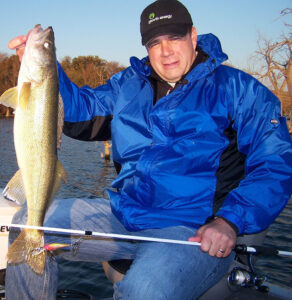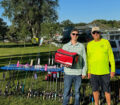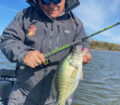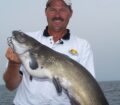By Bob Jensen
Fishing the Midwest Fishing Team

(photo by Bob Jensen) This fall South Dakota walleye came out of a flooded forest, an unusual place to catch walleyes, but on that lake on that day, that’s where they were.
The nights are getting cooler, and the early teal and dove seasons just opened. The early migrating birds are starting to group up as they prepare for the journey to their wintering grounds. These are reminders to me that autumn is on the way, and that’s a reminder of a couple of late summer and fall fishing memories of mine. There’s still warm weather fishing ahead, but let’s venture back in time and remember what made a couple of those late summer and fall fishing memories special. Those memories might provide what it takes to create future fall fishing memories.
The first memory takes place on a chain of lakes in Ontario. This was back in the 80’s and the fishing world was an exciting place. We were learning a lot of new things about fish, and there were also a lot of new fishing products entering the fishing scene. This was when LCD(liquid crystal display) sonar units were first coming into the picture as a fishing tool.
Flasher units had been our primary way of locating drop-offs and structure and other underwater things. The problem with the flasher unit was, if you looked away from the screen and a fish showed up, it would be gone by the time you looked back. You wouldn’t know that you had just gone over a fish or several fish. They would only show up for a second or two. The LCD created a picture of what was happening and what had happened. It showed you what you didn’t see under the boat while you were watching where you were going. Very helpful.
At this point in time, most walleye anglers fished structure: sunken islands, underwater humps, that sort of thing. Much of the time that worked out pretty well. On this day, however, as we moved from one structure to another, we had to cross some deep water. With the new LCD unit, we could see a line across the entire screen about 25’ below the surface over water a 100’ deep. We saw what we assumed were baitfish just above the line, and we also saw what we assumed were bigger fish around the baitfish.
A quick look in the LCD’s owner’s manual revealed that the line was the thermocline, the area in a column of water where the water temperature changed very quickly. The baitfish and walleyes were holding just above the thermocline. We tied on deep diving crankbaits similar to a Banana Shad. These ran just a little shallower than the thermocline and the walleyes were very willing to eat them. They were mostly larger walleyes, and we probably wouldn’t have caught them without the LCD. A good late summer fishing memory and learning experience.
Another nice memory regarding catching walleyes at an, at the time, unusual depth: My Dad and I were fishing for walleyes on Leech Lake in north central Minnesota. We were fishing among a group of boats near a point on the main part of the lake. We were all fishing water 8-10’ feet deep with jigs. No one was catching much. The wind was blowing into the point.
I got snagged. As I tried to get unsnagged, we drifted into shallower water. While I was getting my jig loose, Dad continued to cast. In the time it took me to get the jig loose, Dad caught two walleyes. We started casting to the shallows and learned that the walleyes were in water two to three feet deep. We caught lots of them in the next couple of hours and were soon joined by other anglers who also got in on the catching.
Since then I’ve caught lots of walleyes in the shallows across the Midwest, but at that time many years ago, walleyes weren’t thought to be shallow water fish and not many anglers fished for them shallow. They do now, especially when the wind is blowing into an area.
In the next few weeks, don’t hesitate to try something in your fishing that might seem a bit odd. In fact, never hesitate to try something a bit odd. You might learn that the fish sometimes like things that are a bit odd.

















